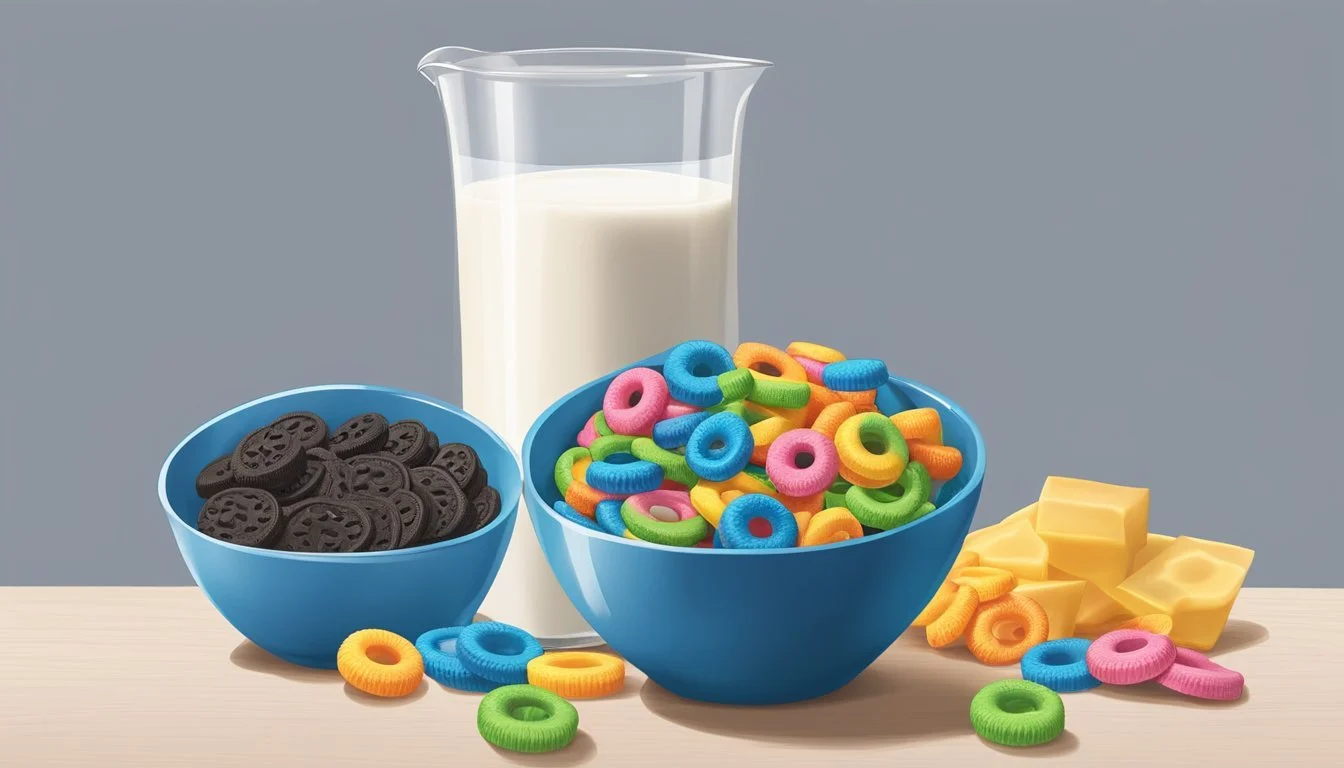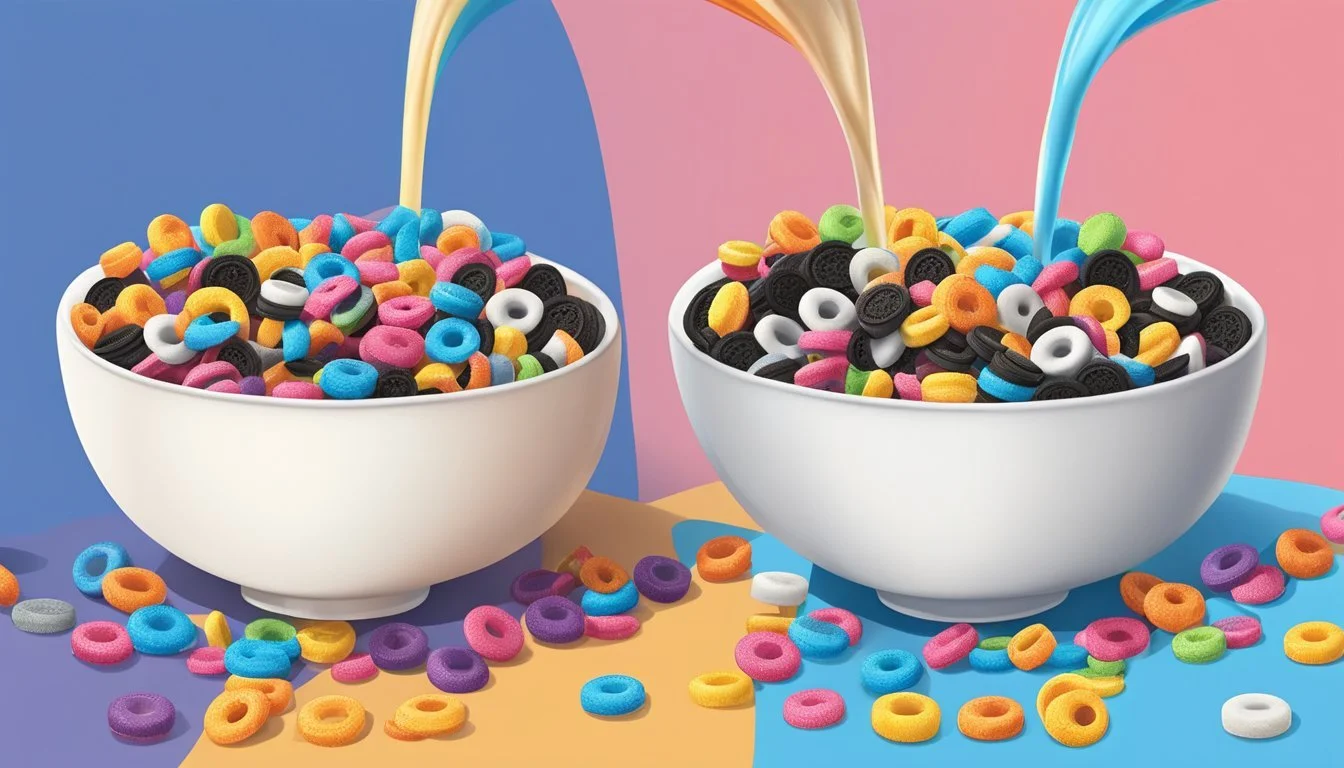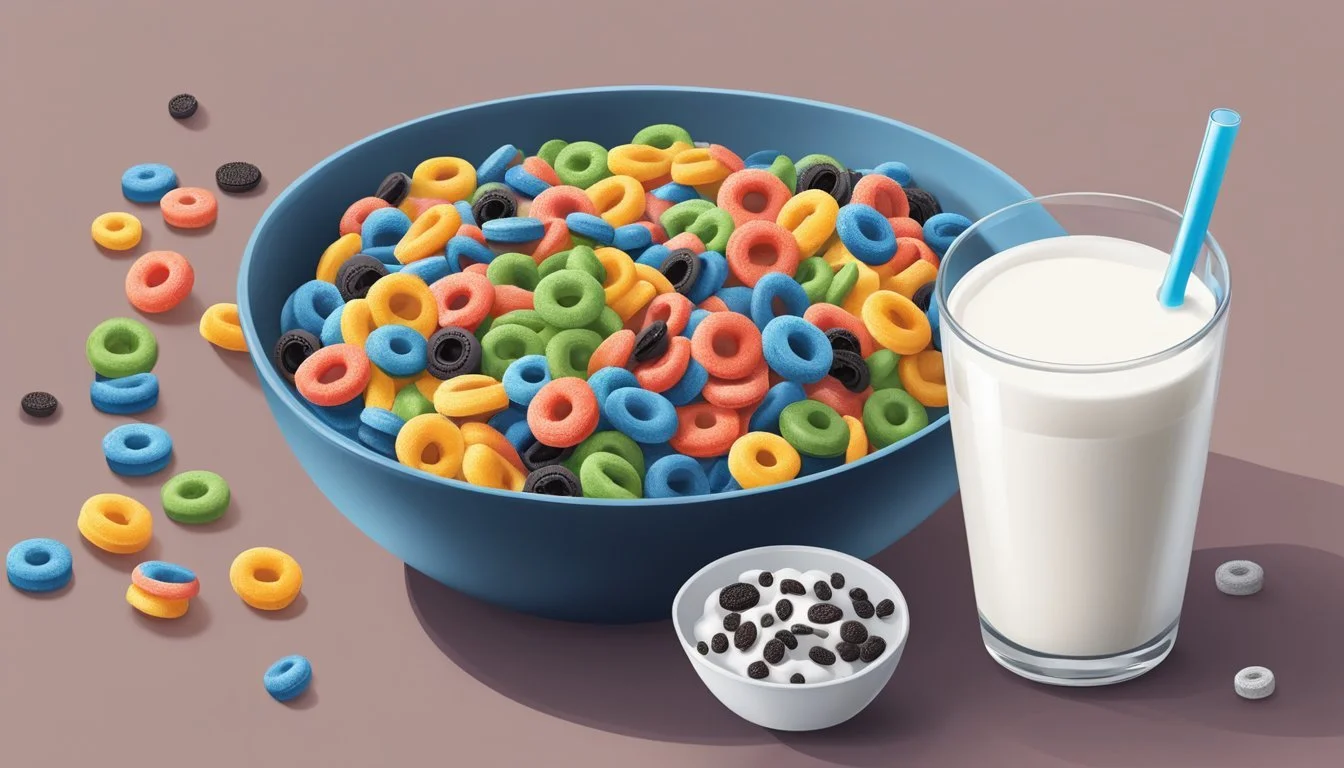Kellogg's Froot Loops vs Oreo O's
Comparing Two Iconic Cereals
This Article is Part of Our Breakfast Cereal Guide with Details on Kellogg's Froot Loops Nutrition and Oreo O's Nutrition
When it comes to choosing a breakfast cereal, Kellogg's Froot Loops and Oreo O's are two popular contenders. Both cereals offer a unique combination of flavors and textures that appeal to children and adults alike. Froot Loops, with its vibrant colors and fruity flavors, has been a favorite for generations. Meanwhile, Oreo O's, with its chocolatey taste that mimics the iconic Oreo cookie, offers an indulgent alternative.
Froot Loops, introduced by Kellogg's, has maintained its place in breakfast routines thanks to its colorful rings and sugary taste. Despite its high sugar content, many enjoy its classic flavor both with milk and as a dry snack. On the other hand, Oreo O's, originally launched by General Mills and now made by Post, captures the essence of a beloved cookie in cereal form, appealing to chocolate lovers everywhere.
For those deciding between the two, the choice essentially boils down to personal taste preferences: fruity versus chocolatey. Both cereals have their merits, but their distinct flavors set them apart in the breakfast aisle.
History and Brand Overview
Kellogg's Froot Loops and Oreo O's are two iconic cereals with rich histories and unique brand identities. Both cereals have captivated consumers with their distinct flavors and branding strategies.
Origins of Kellogg’s Froot Loops
Froot Loops were introduced by Kellogg's in 1963 as a fruit-flavored cereal. The cereal's colorful rings initially came in three colors: red, orange, and yellow. The pieces are ring-shaped and sweetened, appealing to children and adults alike.
The idea for Froot Loops arose from the failure of Kellogg's OKs, a cereal designed to imitate Cheerios by General Mills. OKs featured pieces shaped like "O"s and "K"s and had a highlander as its mascot. Unfortunately, OKs did not succeed and were discontinued in 1962.
In contrast, Froot Loops quickly gained popularity, partly due to its vibrant marketing and beloved mascot, Toucan Sam. Over the years, new colors and flavors were added, making the product even more appealing.
Genesis of Oreo O's
Oreo O's were launched by Post Consumer Brands in 1997, inspired by the beloved Oreo cookies. The cereal features chocolate-flavored O-shaped pieces coated with a hint of crème flavor, replicating the taste of an Oreo.
Oreo O's filled a niche for those looking to enjoy their favorite cookie experience in a breakfast cereal format. The product experienced significant success initially, gaining a strong following among cereal enthusiasts and Oreo fans alike.
In 2007, a corporate separation between Kraft (owning Oreo) and Post (producing the cereal) led to Oreo O's being discontinued in many markets. However, the cereal made a comeback in 2017, returning to shelves due to popular demand. Its reintroduction was celebrated by fans eager to relive their nostalgic breakfast moments.
Nutritional Comparison
This section will examine the differences between Kellogg's Froot Loops and Oreo O's in terms of their caloric content, sugar levels, vitamins, minerals, and presence of artificial colors and flavors.
Caloric Content and Sugar Levels
Kellogg's Froot Loops contain approximately 110 calories per serving. They include a significant amount of sugar, approximately 12 grams per serving. This translates to about 44% of the recommended daily sugar intake for children.
Oreo O's, on the other hand, contain around 120 calories per serving with a slightly lower sugar content of about 10 grams per serving. This makes them a little less sugary compared to Froot Loops.
Comparison Table
Nutrient Froot Loops (per serving) Oreo O's (per serving) Calories 110 120 Sugar (g) 12 10
Vitamins and Minerals Content
Froot Loops are fortified with several essential vitamins and minerals. They contain higher levels of vitamins like Vitamin B12, Vitamin C, and Vitamin B6. Notably, they also offer substantial amounts of Iron and Folic Acid.
Oreo O's are also fortified but differ slightly in their content. They provide a good amount of Vitamin B1 and Vitamin B2, but they are lower in Vitamin C and Iron compared to Froot Loops.
Key Nutritional Content
Froot Loops: Rich in Vitamin B12, Vitamin C, Iron
Oreo O's: Rich in Vitamin B1, Vitamin B2
Presence of Artificial Colors and Flavors
Both cereals contain artificial colors and flavors, which might be a concern for some consumers. Froot Loops are known for their bright colors, including Red 40, Blue 1, Yellow 5, and Yellow 6.
Oreo O's use fewer artificial colors but still include some to achieve their distinct appearance. Both cereals contain artificial flavors to enhance taste.
Artificial Colors in Froot Loops
Red 40
Blue 1
Yellow 5
Yellow 6
Artificial Colors in Oreo O's
Various artificial colors but fewer compared to Froot Loops
The presence of these artificial ingredients means that both cereals are not ideal for individuals looking to avoid synthetic additives.
Ingredient Profiles
In examining the ingredient profiles of Kellogg's Froot Loops and Oreo O's, distinct differences emerge in their core components which influence taste and nutritional value. Each brand employs unique ingredients that define their characteristics.
Core Ingredients of Froot Loops
Froot Loops use a blend of corn flours, specifically whole grain yellow corn flour and degerminated yellow corn flour. These flours form the base of the cereal.
Sugar is a significant component in Froot Loops, contributing to their sweet taste. The cereal also incorporates wheat flour, which adds to its texture and crunch.
Artificial flavors and colors, such as Red 40, Blue 1, and Yellow 6, are used to give Froot Loops their vibrant hues. These additives are often a concern among health-conscious consumers.
Hydrogenated vegetable oil is included for texture and shelf life, while soluble corn fiber is added for some fiber content. Additionally, various vitamins and minerals are fortified into the cereal, such as vitamin C, iron, and niacin.
Main Ingredients in Oreo O's
Oreo O's start with a blend of corn flour and whole grain oat flour, forming the base of the cereal. The incorporation of oat flour distinguishes Oreo O's from Froot Loops.
Sugar and cocoa are key components, giving Oreo O's their distinct chocolate flavor. Unlike Froot Loops, Oreo O's leverage natural and artificial flavors to imitate the iconic Oreo cookie taste.
Whey, derived from milk, is used to enhance the texture and creaminess. Soybean oil is incorporated for consistency, while calcium carbonate is added to boost calcium content.
Artificial colors like Blue 1 and salt are also included. Oreo O's feature a range of fortified vitamins and minerals similar to Froot Loops, including iron and vitamin D, enhancing their nutritional profile.
Taste and Texture
Kellogg's Froot Loops and Oreo O's each bring unique flavors and textures to the breakfast table. Both cereals are known for their distinct taste profiles and crunchiness.
Flavor Profile Comparison
Froot Loops boast a fruity flavor that comes from a blend of natural fruit flavors such as orange, lemon, grape, and cherry. Despite the different colors, all loops taste the same, delivering a consistent fruity punch.
Oreo O's, on the other hand, mimic the taste of the classic Oreo cookie. They combine a rich chocolatey flavor with hints of creamy, vanilla-like sweetness. This distinct combination makes Oreo O's particularly appealing to those with a preference for dessert-inspired cereals.
Crunchiness and Mouthfeel
In terms of texture, Froot Loops offer a crunchy experience that stays relatively firm even when soaked in milk. The cereal's round shape and airy composition contribute to its satisfying crunch.
Oreo O's are equally crunchy, though they can become slightly softer in milk compared to Froot Loops. The addition of marshmallow pieces in some versions adds a chewiness that contrasts with the crispness of the chocolatey O's.
Both cereals provide a pleasant mouthfeel, but the choice between them may come down to whether you prefer the straightforward crunch of Froot Loops or the varied texture of Oreo O's.
Variety and Product Options
Both Kellogg's Froot Loops and Oreo O's offer varied products that cater to different tastes and preferences, from marshmallow-infused treats to health-conscious options.
Available Froot Loops Variations
Kellogg's Froot Loops are best known for their colorful, fruity cereal rings. Besides the classic version, there are variations with marshmallows that add extra sweetness and texture. There are also limited editions that feature unique shapes, such as stars or seasonal themes like Halloween or Christmas.
Froot Loops with Marshmallows adds a mix of colors and fun shapes to the traditional loops, making it a hit among kids and adults who enjoy a sugary treat. Additionally, Kellogg's occasionally releases gluten-free or low-sugar versions to cater to health-conscious consumers.
Oreo O's Related Products
Oreo O's, inspired by the classic Oreo cookie, have their own range of cereal products. The original Oreo O's cereal consists of chocolate-flavored O's with a sugary coating. Over the years, variations have included cereals mixed with marshmallow bits for added texture.
Post Consumer Brands, the manufacturer of Oreo O's, has also experimented with limited edition flavors. These might integrate elements of frosted flakes or other crunchy textures, appealing to those who love a mix of flavors in their breakfast bowl.
In summary, both brands diversify their offerings, ensuring there's something for every preference, from traditional lovers to those seeking novelty.
Packaging and Availability
Kellogg's Froot Loops and Oreo O's each have distinct packaging designs and are widely available both in physical grocery stores and through various online retailers. This section will examine these two aspects in detail.
Grocery Store Presence
Kellogg's Froot Loops:
Packaging: The Froot Loops package features a colorful, large logo with a bowl of cereal prominently displayed. The bright, multicolored loops are a key visual element.
Availability: Found in almost every supermarket around the world, Froot Loops occupy a prominent space on cereal shelves. This ubiquity makes them a go-to choice for many consumers.
Oreo O's:
Packaging: Oreo O’s packaging is designed to be instantly recognizable with its distinct blue background and depiction of chocolatey O-shaped cereal mixed with white marshmallows.
Availability: Oreo O's are also widely available in many grocery stores. Though they have experienced periods of discontinuation, they remain a popular item since their re-release.
Online Purchase Options
Kellogg's Froot Loops:
E-commerce: Easily available through various online retailers such as Amazon, Walmart, and Target. These platforms often offer bulk buying options and subscription services for regular delivery.
Additional Options: Specialty online stores and Kellogg's official site also offer Froot Loops, sometimes featuring limited edition packaging or flavors exclusive to online consumers.
Oreo O's:
E-commerce: Oreo O’s can be purchased from major websites like Amazon, Walmart, and other grocery delivery services. These sites provide convenience for those who prefer online shopping.
Additional Options: Some international versions of Oreo O's may be found on import sites, catering to enthusiasts looking for unique flavors or packaging variations not available locally.
Dietary Considerations
Froot Loops and Oreo O's have diverse dietary profiles, catering to different nutritional needs and preferences. Consumers often look for options that align with gluten-free, vegan, and other dietary lifestyles.
Gluten-Free and Vegan Options
Froot Loops contain gluten, making them unsuitable for individuals with celiac disease or gluten intolerance. They also include animal-derived Vitamin D3, making them non-vegan.
Oreo O's, while not specifically labeled gluten-free, do have some variations or recipes that could be free from gluten and may be more accommodating for those avoiding it. However, they are not entirely vegan due to certain ingredients such as milk derivatives.
Both cereals are typically not labeled as non-GMO, high-protein, grain-free, or keto-friendly. Consumers with specific dietary needs should read food labels carefully and consult with manufacturers if necessary.
Brand Messaging and Marketing
Kellogg's Froot Loops and Oreo O's utilize distinct brand messaging and marketing strategies to appeal to their specific demographics, emphasizing different aspects of experience and cultural connection.
Advertising Strategies
Kellogg's Froot Loops employs the memorable tagline "Follow Your Nose!", reinforced by the character Toucan Sam. This phrase highlights the cereal's fruity flavors, aimed at sparking curiosity and nostalgia.
Froot Loops advertising often focuses on visually appealing, colorful imagery, tying the product to a fun and playful breakfast experience. Campaigns typically run during morning cartoon hours, targeting younger audiences and their parents.
Oreo O's leverage the iconic Oreo cookie brand. Marketing materials emphasize the cereal's authentic Oreo flavor and a sense of indulgence. Advertisements feature vibrant visuals showcasing the cereal in various snacking contexts, appealing to consumers looking for that familiar Oreo taste throughout their day.
Target Demographics
Froot Loops mainly targets children and their parents. The playful imagery and Toucan Sam's adventures make it appealing to kids, while the nostalgia factor attracts parents who remember the cereal from their own childhoods.
Additionally, Kellogg's has broadened its reach by creating branded merchandise that resonates with Millennials. Partnerships with lifestyle brands have featured nostalgic pieces, drawing in consumers who grew up with Froot Loops but are now adults.
Oreo O's focuses on a slightly older demographic, including teenagers and young adults. Their marketing appeals to those who enjoy Oreos in various forms, whether for breakfast or as a snack.
Positioned as an indulgent treat rather than just a breakfast cereal, Oreo O's advertising pushes the boundaries beyond morning meals, resonating with snackers and late-night eaters.
Consumer Insights
Consumers of Kellogg's Froot Loops and Oreo O's have a diverse range of opinions and shifting preferences influenced by factors like taste, color variety, and experiences with sugar crashes.
Loyalty and Repeat Purchases
Kellogg's Froot Loops enjoy a loyal customer base derived from their vibrant colors and familiar fruity taste. Many who grew up eating Froot Loops continue to purchase them as adults due to nostalgia.
Oreo O's, despite their on-and-off availability, attract loyal consumers primarily through their unique blend of chocolate and cookie flavors. The distinct taste of Oreo O's appeals to both children and adults, making it a recurring choice in households.
Sugar levels in both cereals influence repeat purchases somewhat negatively, with some consumers reporting experiences of a sugar crash after consumption, which affects their decisions to repurchase.
Consumer Reviews and Preferences
Reviews for Froot Loops often highlight the colorful and visually appealing nature of the cereal. Many consumers enjoy the consistent fruity flavor, though some express disappointment after learning all loops taste the same.
In contrast, Oreo O's reviews frequently mention the cereal's rich, chocolatey flavor that replicates the taste of Oreo cookies. Consumers appreciate the unique flavor profile, but some reviews raise concerns about the high sugar content and its effects.
Color and presentation play a significant role in the preferences for Froot Loops. For Oreo O's, the distinctive cookie taste is the main attraction, with any concerns largely centered around health aspects.
Comparative Analysis
When comparing Kellogg's Froot Loops to Oreo O's, it's vital to consider their health benefits and concerns. This analysis will focus on key nutritional elements, such as added sugar, artificial flavors, and the overall health implications of choosing these cereals for breakfast.
Health Benefits and Concerns
Both Kellogg's Froot Loops and Oreo O's are ready-to-eat cereals often marketed toward children.
Froot Loops contain added sugars and artificial flavors. A typical serving size offers about 150 calories, 35 grams of carbs, and 16 grams of sugar. The vitamin B12 content is notably high, contributing significantly to daily intake, but the overall nutrient profile is limited.
Oreo O's, on the other hand, also contain a substantial amount of added sugars and artificial components. Their calorie count per serving is similar, but the sugar content can be higher depending on the serving size. Their vitamin and mineral content may vary, often enriched to appeal as a fortified breakfast option.
Both options fall short of being a healthy breakfast choice concerning natural nutrient density and sugar content, emphasizing the need for moderation in consumption.
More on Kellogg's Froot Loops
Cinnamon Toast Crunch vs Kellogg's Froot Loops: Which is better?
French Toast Crunch vs Kellogg's Froot Loops: Which is better?
Honey Nut Cheerios vs Kellogg's Froot Loops: Which is better?
Kellogg's Apple Jacks vs Kellogg's Froot Loops: Which is better?
Kellogg's Froot Loops vs Post GrapevsNut Flakes: Which is better?
Kellogg's Froot Loops vs Post Raisin Bran Cereal: Which is better?








